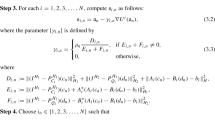Abstract
In this paper, we study the performance of the Semidefinite Linear Complementarity Problem (SDLCP) for symmetric matrices that is equipped with a continuously differentiable potential function. A practical homogeneous self-dual potential reduction algorithm based on this potential function is prescribed, and we establish a computational basis for interior point methods with the use of HKM directions towards the central trajectory for the monotone SDLCP. Our computational implementation maintains a global linear polynomial time convergence, while achieving strong practical performance in comparison with existing solution methods.
Similar content being viewed by others
References
Kocvara: Sparse SDP’s from structural optimization. http://plato.asu.edu/ftp/kocvara/
SDP: More SDP problems. http://plato.asu.edu/ftp/sdp/
Andersen, E.D., Ye, Y.: A computational study of the homogeneous algorithm for large scale convex optimization. Comput. Optim. Appl. 10, 243–269 (1998)
Andersen, E.D., Ye, Y.: On a homogeneous algorithm for the monotone complementarity problem. Math. Progr. 84, 375–399 (1999)
Borchers, B.: SDPLIB 1.2, a library of semidefinite programming test problems. Optim. Methods Softw. 11 & 12, 683–690 (1999)
Brixius, N., Potra, F.A., Sheng, R.: Sdpha: a matlab implementation of homogeneous interior-point algorithms for semidefinite programming. Optim. Methods Softw. 11(1–4), 583–596 (1999)
Chen, F., Zuo, Z.: Polynomial convergence of predictor-corrector for SDLCP based on the M-Z family of directions. Int. Math. Forum. 6, 1127–1134 (2011)
Freund, R.M.: Polynomial-time algorithms for linear programming based only on primal scaling and projected gradients of a potential function. Math. Program. 51, 203–222 (1991)
Goldfarb, D., Mehrotra, S.: A relaxed variant of Karmarkar’s algorithm. Math. Program. 40, 285–315 (1988)
Grant, M., Boyd, S.: CVX: matlab software for disciplined convex programming, version 2.0 beta. http://cvxr.com/cvx (2013)
Grant, M., Boyd, S.: Graph implementations for nonsmooth convex programs, recent advances in learning and control (a tribute to M. Vidyasagar). In: Blondel, V., Boyd, S., Kimura, H., (eds.) Lecture notes in control and information sciences, pp. 95–110 (2008)
Helmberg, C., Rendl, F., Vanderbei, R.J., Wolkowicz, H.: An interior-point method for semidefinite programming. SIAM J. Optim. 6, 342–361 (1996)
Kojima, M., Mizuno, S., Yoshise, A.: An \(O(\sqrt{n}L)\) iteration potential reduction algorithm for linear complementary problems. Math. Program. 50, 331–342 (1991)
Kojima, M., Shindoh, S., Hara, S.: Interior-point methods for the monotone semidefinite linear complementarity problem in symmetric matrices. SIAM J. Optim. 7, 86–125 (1997)
Kojima, M., Shida, M., Shindoh, S.: Search directions in the SDP and the monotone SDLCP: generalization and inexact computation. Math. Program. 85, 51–80 (1999)
Karmarkar, N.: A new polynomial-time algorithm for linear programming. Combinatorica 4, 373–395 (1984)
Mizuno, S., Kojima, M., Todd, M.: Infeasible interior point primal dual potential reduction algorithms for linear programming. SIAM J. Optim. 5(1), 52–67 (1995)
Monteiro, R.D.C., Tsuchiya, T.: Polynomiality of primal dual algorithms for semidefinite linear complementarity problems based on the Kojima-Shindoh-Hara family of directions. Math. Program. 84, 39–53 (1999)
Monteiro, R.D.C.: Primal-dual path-following algorithms for semidefinite programming. SIAM J. Optim. 7, 663–678 (1997)
Mehorotra, S., Huang, K.L.: Computational experience with a modified potential reduction algorithm for linear programming. Optim. Methods Softw. 27, 865–891 (2012)
Nie, J., Yuan, Y.: A potential reduction algorithm for an extended SDP problem. Sci. China Ser. A Math. 43, 35–46 (2000)
Potra, F.A., Sheng, R.: On homogeneous interior point algorithms for semidefinite programming. Optim. Methods Softw. 9(1–3), 161–184 (1998)
Potra, F.A., Sheng, R.: A superlinearly convergent primal dual infeasible interior point algorithm for semidefinite programming. SIAM J. Optim. 8, 1007–1028 (1998)
Slater, M.: Lagrange multipliers revisited: a contribution to non-linear programming. Cowels commission discussion paper. Mathematics 403 (1950)
Toh, K.C.: A note on the calculations of step lengths in interior point methods for semidefinite programming. Comput. Optim. Appl. 21, 301–310 (2002)
Tanabe, K.: Centered Newton method for mathematical programming. Syst. Model. Optim. 113, 197–206 (1988)
Todd, M., Ye, Y.: A centered projective algorithm for linear programming. Math. Oper. Res. 15, 508–529 (1990)
Todd, M.J.: Potential-reduction methods in mathematical programming. Math. Program. 76, 3–45 (1996)
Toh, K.C., Todd M.J., Tütüncü, R.H.: On the implementation and usage of SDPT3—a Matlab software package for semidefinite quadratic linear programming. Version 4.0 (2010)
Tütüncü, R.H., Toh, K.C., Todd, M.J.: Solving semidefinite quadratic linear programs using SDPT3. Math. Program. 95, 189–217 (2003)
Vandenberghe, L., Boyd, S.: Applications of semidefinite programming. Appl. Numer. Math. 29, 283–299 (1999)
Xu, X., Hung, P., Ye, Y.: A simplified homogeneous and self dual linear programming algorithm and its implementation. Ann. Oper. Res. 62, 151–171 (1996)
Ye, Y.: A class of potential functions for linear programming. Technical report, department of management sciences, The University of Iowa (1988)
Ye, Y., Todd. M.J., Mizuno, S.: An \(O(\sqrt{n}L)-\) iteration homogenous and self dual linear programming algorithm. Technical report. 1007 (1992)
Author information
Authors and Affiliations
Corresponding author
Rights and permissions
About this article
Cite this article
Nayak, R.K., Desai, J. A modified homogeneous potential reduction algorithm for solving the monotone semidefinite linear complementarity problem. Optim Lett 10, 1417–1448 (2016). https://doi.org/10.1007/s11590-015-0940-1
Received:
Accepted:
Published:
Issue Date:
DOI: https://doi.org/10.1007/s11590-015-0940-1




